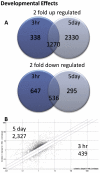Transcriptional changes in Schistosoma mansoni during early schistosomula development and in the presence of erythrocytes
- PMID: 20161728
- PMCID: PMC2817720
- DOI: 10.1371/journal.pntd.0000600
Transcriptional changes in Schistosoma mansoni during early schistosomula development and in the presence of erythrocytes
Abstract
Background: Schistosomes cause more mortality and morbidity than any other human helminth, but control primarily relies on a single drug that kills adult worms. The newly transformed schistosomulum stage is susceptible to the immune response and is a target for vaccine development and rational drug design.
Methodology/principal findings: To identify genes which are up-regulated during the maturation of Schistosoma mansoni schistosomula in vitro, we cultured newly transformed parasites for 3 h or 5 days with and without erythrocytes and compared their transcriptional profiles using cDNA microarrays. The most apparent changes were in the up-regulation of genes between 3 h and 5 day schistosomula involved in blood feeding, tegument and cytoskeletal development, cell adhesion, and stress responses. The most highly up-regulated genes included a tegument tetraspanin Sm-tsp-3 (1,600-fold up-regulation), a protein kinase, a novel serine protease and serine protease inhibitor, and intestinal proteases belonging to distinct mechanistic classes. The inclusion of erythrocytes in the culture medium resulted in a general but less pronounced increase in transcriptional activity, with the highest up-regulation of genes involved in iron metabolism, proteolysis, and transport of fatty acids and sugars.
Conclusions: We have identified the genes that are up-regulated during the first 5 days of schistosomula development in vitro. Using a combination of gene silencing techniques and murine protection studies, some of these highly up-regulated transcripts can be targeted for future development of new vaccines and drugs.
Conflict of interest statement
The authors have declared that no competing interests exist.
Figures






Similar articles
-
Suppression of mRNAs encoding tegument tetraspanins from Schistosoma mansoni results in impaired tegument turnover.PLoS Pathog. 2010 Apr 15;6(4):e1000840. doi: 10.1371/journal.ppat.1000840. PLoS Pathog. 2010. PMID: 20419145 Free PMC article.
-
A quantitative proteomic analysis of the tegumental proteins from Schistosoma mansoni schistosomula reveals novel potential therapeutic targets.Int J Parasitol. 2015 Jul;45(8):505-16. doi: 10.1016/j.ijpara.2015.03.004. Epub 2015 Apr 21. Int J Parasitol. 2015. PMID: 25910674
-
Gene expression patterns in larval Schistosoma mansoni associated with infection of the mammalian host.PLoS Negl Trop Dis. 2011 Aug;5(8):e1274. doi: 10.1371/journal.pntd.0001274. Epub 2011 Aug 30. PLoS Negl Trop Dis. 2011. PMID: 21912711 Free PMC article.
-
Mechanisms of evasion of Schistosoma mansoni schistosomula to the lethal activity of complement.Mem Inst Oswaldo Cruz. 1992;87 Suppl 4:111-6. doi: 10.1590/s0074-02761992000800016. Mem Inst Oswaldo Cruz. 1992. PMID: 1285336 Review.
-
Biology of the schistosome lung-stage schistosomulum.Parasitology. 2007 Apr;134(Pt 4):453-60. doi: 10.1017/S0031182006001648. Epub 2006 Nov 17. Parasitology. 2007. PMID: 17109780 Free PMC article. Review.
Cited by
-
Solution structure, membrane interactions, and protein binding partners of the tetraspanin Sm-TSP-2, a vaccine antigen from the human blood fluke Schistosoma mansoni.J Biol Chem. 2014 Mar 7;289(10):7151-7163. doi: 10.1074/jbc.M113.531558. Epub 2014 Jan 15. J Biol Chem. 2014. PMID: 24429291 Free PMC article.
-
Computational deconvolution of gene expression by individual host cellular subsets from microarray analyses of complex, parasite-infected whole tissues.Int J Parasitol. 2016 Jun;46(7):447-52. doi: 10.1016/j.ijpara.2016.02.003. Epub 2016 Mar 26. Int J Parasitol. 2016. PMID: 27025770 Free PMC article.
-
T Cell Peptides Derived from Invasive Stages of Schistosoma mansoni as Potential Schistosomiasis Vaccine.J Clin Med. 2021 Jan 24;10(3):445. doi: 10.3390/jcm10030445. J Clin Med. 2021. PMID: 33498845 Free PMC article.
-
Schistosoma mansoni schistosomula antigens induce Th1/Pro-inflammatory cytokine responses.Parasite Immunol. 2018 Dec;40(12):e12592. doi: 10.1111/pim.12592. Epub 2018 Oct 21. Parasite Immunol. 2018. PMID: 30239006 Free PMC article.
-
Molecular characterization of host-parasite cell signalling in Schistosoma mansoni during early development.Sci Rep. 2016 Oct 20;6:35614. doi: 10.1038/srep35614. Sci Rep. 2016. PMID: 27762399 Free PMC article.
References
-
- Doenhoff MJ, Cioli D, Utzinger J. Praziquantel: mechanisms of action, resistance and new derivatives for schistosomiasis. Curr Opin Infect Dis. 2008;21:659–667. - PubMed
-
- Loukas A, Tran M, Pearson MS. Schistosome membrane proteins as vaccines. Int J Parasitol. 2007;37:257–263. - PubMed
-
- Braschi S, Borges WC, Wilson RA. Proteomic analysis of the schistosome tegument and its surface membranes. Mem Inst Oswaldo Cruz. 2006;101(Suppl 1):205–212. - PubMed
Publication types
MeSH terms
LinkOut - more resources
Full Text Sources
Molecular Biology Databases
Miscellaneous

